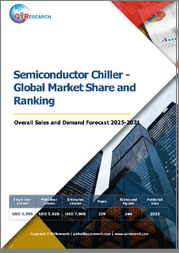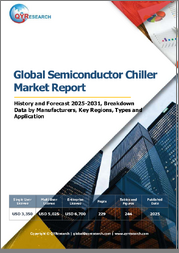
|
시장보고서
상품코드
1494513
아시아태평양의 냉동기 시장 예측(-2030년) : 지역별 분석 - 기술, 유형 및 용도별 분석Asia Pacific Chillers Market Forecast to 2030 - Regional Analysis - by Technology, Type, and Application |
||||||
아시아태평양의 냉동기 시장은 2022년 50억 85만 달러에서 2030년 80억 6,257만 달러로 성장할 것으로 예상되며, 2022-2030년간 CAGR은 6.2%로 추산됩니다.
IoT 지원 HVAC 냉동기 시장 개척으로 아시아태평양의 냉동고 시장 성장 촉진
IoT 혁명의 초기 단계에 접어들면서 IoT는 난방, 환기 및 공조(HVAC) 산업에 그 발자취를 남기고 있으며, IoT 지원 HVAC 제품은 많은 고객이 HVAC 시스템의 효율성을 극대화하는 데 도움을 주고 있습니다. 스마트 시티의 사람들은 최신 기술과 장치로 집을 스마트 홈으로 바꾸고 있습니다. 선진국에서 첨단 기술이 채택되는 배경에는 강력한 경제 상황과 이를 뒷받침하는 인프라가 있습니다.
단기간 내에 HVAC 냉동기는 사람의 손이 덜 필요하거나 전혀 필요 없이 스스로 미세 조정하고 설정을 변경할 수 있게 될 것으로 보입니다. 간단히 말해, HVAC 냉동기는 특정 조건에 따라 필요한 판단을 스스로 내릴 수 있게 될 것이며, TCS는 Voltas가 냉동기의 고장을 방지할 수 있는 원격 냉동고 모니터링 시스템을 개발할 수 있도록 돕고 있습니다. 인텔은 IoT 게이트웨이를 도입하고, TCS는 IoT 프레임워크를 활용하며, Voltas는 냉동기에 대한 전문 지식을 활용하여 여러 지역의 냉동기를 원격으로 모니터링할 수 있는 중앙집중식 시스템을 공동 개발했습니다. 를 통해 냉동기의 실시간 상태를 진단하고, 장비 매개변수 이상을 식별하고, 각 현장 엔지니어에게 알림과 경고를 제공하여 장비 고장을 예측하고 예방적 유지보수를 할 수 있도록 돕습니다.
아시아태평양의 냉동기 시장 개요
아시아태평양 HVAC 냉동기 시장은 호주, 중국, 인도, 일본, 한국 및 기타 아시아태평양으로 구분됩니다. 도시의 산업화, 소비자의 가처분 소득 증가, 고급 제품에 대한 수요 증가, 지구 온난화에 초점을 맞춘 정부의 엄격한 규범 등이 아시아태평양 HVAC 냉동기 시장의 성장 요인으로 작용하고 있습니다. 중국, 인도와 같은 국가의 건설 부문은 특히 소매 공간, 상업용 오피스 빌딩, 제조 시설, 공항 확장 및 건설을 위해 막대한 투자를 하고 있습니다. 중국민용항공국(CAAC)에 따르면 중국은 항공 수요 증가에 대응하기 위해 2035년까지 216개의 새로운 공항을 건설하는 것을 목표로 하고 있으며, 2020년 아시아 지역의 건축 건설 지출은 4조 5,000억 달러 이상에 달할 것으로 예상되며 이는 전 세계 건설 프로젝트 지출의 약 50%에 해당합니다. 에 해당합니다. 또한, 신흥국과 선진국에서 그린 빌딩과 같은 새로운 트렌드의 확산과 채택이 확대됨에 따라 HVAC 냉동기 시장 진출기업들에게 큰 성장 기회를 제공합니다. 에너지 소비를 억제하고 에너지 효율을 높이기 위한 엄격한 정부 규범과 기준도 그린 테크놀러지 수용 확대에 기여하고 있습니다. 세계그린빌딩협의회(World GBC)에 따르면, 호주(약 46%)와 중국(약 42%)은 그린빌딩 건설 지원에 크게 집중하고 있습니다. 또한 인도, 일본, 중국 등 국가들은 상업용 건물 프로젝트에 많은 투자를 하고 있으며, 이는 HVAC 냉동기에 대한 수요를 더욱 증가시키고 있습니다. 중국과 일본의 초고층 빌딩 건설에 대한 관심이 높아짐에 따라 아시아태평양의 HVAC 냉동기 시장 진출기업들이 번창할 수 있는 새로운 기회를 제공합니다.
아시아태평양의 냉동기 시장 매출 및 2030년까지의 예측(금액)
아시아태평양의 냉동고 시장 세분화
아시아태평양의 냉동기 시장은 기술, 유형, 용도, 국가별로 세분화됩니다.
기술별로 아시아태평양의 냉동기 시장은 공랭식, 수냉식, 증기 연소식 등으로 구분됩니다. 공랭식 부문은 2022년 아시아태평양의 냉동기 시장에서 가장 큰 점유율을 차지했습니다.
유형별로는 아시아태평양의 냉동기 시장은 공정용 냉동기, 스크롤 냉동기, 스크류 냉동기, 터보 냉동기, 흡수식 냉동기, 모듈식 냉동기, 역순환 냉동기 등으로 구분되며, 스크류 냉동기 부문은 2022년 아시아태평양의 냉동기 시장에서 가장 큰 점유율을 차지할 것으로 예상됩니다. 를 차지할 것으로 예상됩니다.
용도별로는 아시아태평양의 냉동기 시장은 산업용, 상업용, 주거용으로 구분되며, 2022년 아시아태평양의 냉동기 시장에서 산업용 부문이 가장 큰 점유율을 차지할 것으로 예상됩니다.
국가별로 보면 아시아태평양의 냉동고 시장은 호주, 중국, 중국, 인도, 일본, 한국, 기타 아시아태평양으로 구분되며, 2022년 아시아태평양의 냉동고 시장은 중국이 주도할 것으로 예상됩니다.
LG Electronics Inc, Mitsubishi Electric Corp, Carrier Global Corp, Daikin Industries Ltd, Thermal Care, Inc, Tran Inc, Kaltra, SKM Air Conditioning Airdale International Air Conditioning Ltd는 아시아태평양의 냉동기 시장에서 사업을 전개하고 있는 주요 기업입니다.
목차
제1장 서론
제2장 주요 요약
- 주요 인사이트
- 시장의 매력
제3장 조사 방법
- 조사 범위
- 2차 조사
- 1차 조사
제4장 아시아태평양의 냉동기 시장 구도
- 개요
- PEST 분석
- 아시아태평양
- 생태계 분석
제5장 아시아태평양의 냉동기 시장 - 주요 산업 역학
- 냉동기 시장 - 주요 산업 역학
- 시장 성장 촉진요인
- 시장 성장 억제요인
- 시장 기회
- 향후 동향
- 성장 촉진요인과 억제요인의 영향
제6장 냉동기 시장 : 아시아태평양 시장 분석
- 냉동기 시장 판매량, 2022-2030년
- 냉동기 시장 예측과 분석
제7장 아시아태평양의 냉동기 시장 분석 : 기술별
- 개요
- 냉동기 시장 : 기술별(2022년, 2030년)
- 공랭식
- 공랭식 시장 매출과 2030년까지 예측
- 수냉식
- 수냉식 개요
- 수냉식 시장 매출과 2030년까지 예측
- 증기 연소식
- 증기 연소식 시장 매출과 2030년까지 예측
제8장 아시아태평양의 냉동기 시장 분석 : 유형별
- 개요
- 아시아태평양의 냉동기 시장 : 유형별(2022년, 2030년)
- 프로세스 냉동기
- 프로세스 냉동기 시장 매출과 2030년까지 예측
- 스크롤 냉동기
- 스크롤 냉동기 개요
- 스크롤 냉동기 시장 매출과 2030년까지 예측
- 스크류 냉동기
- 스크류 냉동기 시장 매출과 2030년까지 예측
- 터보 냉동기
- 터보 냉동기 개요
- 터보 냉동기 시장 매출과 2030년까지 예측
- 흡수식 냉동기
- 흡수식 냉동기 개요
- 흡수식 냉동기 시장 매출과 2030년까지 예측
- 모듈식 냉동기
- 모듈식 냉동기 시장 매출과 2030년까지 예측
- 역사이클 냉동기
- 역사이클 냉동기 시장 매출과 2030년까지 예측
제9장 아시아태평양의 냉동기 시장 분석 : 용도별
- 개요
- 아시아태평양의 냉동기 시장 : 용도별(2022년, 2030년)
- 상업용
- 상업용 시장 매출과 2030년까지 예측
- 산업용
- 산업용 시장 매출과 2030년까지 예측
- 주택용
- 주택용 시장 개요
- 주택용 시장 매출과 2030년 예측
제10장 아시아태평양의 냉동기 시장 분석 : 국가별
- 아시아태평양
- 중국
- 일본
- 인도
- 한국
- 호주
- 기타 아시아태평양
제11장 업계 상황
- 서론
- 시장 이니셔티브
- 신제품 개발
제12장 기업 개요
- LG Electronics Inc
- Mitsubishi Electric Corp
- Carrier Global Corp
- Daikin Industries Ltd
- Thermal Care, Inc.
- Trane Inc.
- Kaltra
- SKM Air Conditioning
- Airedale International Air Conditioning Ltd
제13장 부록
LSH 24.06.21The Asia Pacific chillers market is expected to grow from US$ 5,000.85 million in 2022 to US$ 8,062.57 million by 2030. It is estimated to register a CAGR of 6.2% from 2022 to 2030.
Development of IoT enabled HVAC Chillers Boosts Asia Pacific Chillers Market
The initial stage of the IoT revolution is on the horizon, and IoT is making its mark on the heat, ventilation, and air conditioning (HVAC) industry. IoT enabled HVAC products are helping many customers to maximize the efficiency of their HVAC systems. People in smart cities are transforming their houses into smart homes with latest technologies and devices. The crucial reason behind the adoption of advanced technology in developed countries is the strong economic condition along with supportive infrastructure.
In short period of time, HVAC chillers will be able to fine-tune and make changes in settings for themselves, with lesser or no human input at all. In simple words, HVAC chillers will be able to make the required judgment as per the specific condition on their own. TCS is helping Voltas in developing a remote chiller monitoring system which will be able to prevent the chiller breakdowns. Intel deployed their IoT gateway, TCS made use of their IoT framework and Voltas leveraged their chiller expertise for jointly developing a centralized system which can monitor chillers remotely across distinct geographies. End to end solutions from TCS helps in diagnosing the real-time health of the chillers via live dashboard, identifying anomalies in the equipment parameters and raise notifications and alerts for the respective field engineer and predict failures in equipment for proactive maintenance.
Asia Pacific Chillers Market Overview
Asia-Pacific (APAC) HVAC chillers market is segmented into Australia, China, India, Japan, South Korea, and the Rest of Asia Pacific. The ongoing industrialization of cities, elevating disposable income of consumers, rising demand for luxury products, and stringent government norms focusing on global warming are the factors contributing to the growth of the Asia-Pacific HVAC chillers market. The construction sectors in countries such as China and India are witnessing huge investments, specifically for the establishment of retail spaces, commercial office buildings, and manufacturing facilities, as well as for the expansion and construction of airports. According to Civil Aviation Administration of China (CAAC), China aims to construct 216 new airports by 2035 to meet the growing demands for air travel. In 2020, the building construction spending in Asia crossed US$ 4.5 trillion, which was ~50% of the global expenditure on construction projects. Moreover, the growing popularity and adoption of new trends such as green building in emerging and developed countries is providing significant growth opportunities for the HVAC chillers market players. Stringent government norms and standards for controlling energy consumption and promoting energy-efficient practices is also contributing to the rise in acceptance of green technologies. According to the World Green Building Council (World GBC), Australia (~46%) and China (~42%) majorly focus on supporting the construction of green buildings. Moreover, countries such as India, Japan, and China are investing heavily in commercial building projects, which further propels the HVAC chiller demand. Increasing focus on the construction of skyscrapers in China and Japan is offering new opportunities for the flourishment of the HVAC chillers market players in Asia Pacific.
Asia Pacific Chillers Market Revenue and Forecast to 2030 (US$ Million)
Asia Pacific Chillers Market Segmentation
The Asia Pacific chillers market is segmented into technology, type, application, and country.
Based on technology, the Asia Pacific chillers market is segmented into air-cooled, water-cooled, and steam-fired. The air-cooled segment held the largest share of the Asia Pacific chillers market in 2022.
In terms of type, the Asia Pacific chillers market is segmented into process chillers, scroll chillers, screw chillers, centrifugal chillers, absorption chillers, modular chillers, and reverse cycle chillers. The screw chillers segment held the largest share of the Asia Pacific chillers market in 2022.
Based on application, the Asia Pacific chillers market is segmented into industrial, commercial, and residential. The industrial segment held the largest share of the Asia Pacific chillers market in 2022.
Based on country, the Asia Pacific chillers market is segmented into Australia, China, India, Japan, South Korea, and the Rest of Asia Pacific. China dominated the Asia Pacific chillers market in 2022.
LG Electronics Inc, Mitsubishi Electric Corp, Carrier Global Corp, Daikin Industries Ltd, Thermal Care, Inc, Trane Inc, Kaltra, SKM Air Conditioning, and Airedale International Air Conditioning Ltd are some of the leading companies operating in the Asia Pacific chillers market.
Table Of Contents
1. Introduction
- 1.1 The Insight Partners Research Report Guidance
- 1.2 Market Segmentation
2. Executive Summary
- 2.1 Key Insights
- 2.2 Market Attractiveness
3. Research Methodology
- 3.1 Coverage
- 3.2 Secondary Research
- 3.3 Primary Research
4. Asia Pacific Chillers Market Landscape
- 4.1 Overview
- 4.2 PEST Analysis
- 4.2.1 APAC
- 4.3 Ecosystem Analysis
5. Asia Pacific Chillers Market - Key Industry Dynamics
- 5.1 Chillers Market - Key Industry Dynamics
- 5.2 Market Drivers
- 5.2.1 Rising Demand from Various Industries
- 5.2.2 Increasing Number of Data Centres to Boost Market Growth
- 5.3 Market Restraints
- 5.3.1 Less Efficiency in Humid Environment and High Maintenance Cost
- 5.4 Market Opportunities
- 5.4.1 Economic Growth in Developing Countries Across the World
- 5.5 Future Trends
- 5.5.1 Development of IoT enabled HVAC Chillers
- 5.6 Impact of Drivers and Restraints:
6. Chillers Market - Asia Pacific Market Analysis
- 6.1 Chillers Market Revenue (US$ Million), 2022 - 2030
- 6.2 Chillers Market Forecast and Analysis
7. Asia Pacific Chillers Market Analysis - Technology
- 7.1 Overview
- 7.1.1 Chillers Market , By Technology (2022 and 2030)
- 7.2 Air-Cooled
- 7.2.1 Overview
- 7.2.2 Air-Cooled Market, Revenue and Forecast to 2030 (US$ Million)
- 7.3 Water-Cooled
- 7.3.1 Overview
- 7.3.2 Water-Cooled Market, Revenue and Forecast to 2030 (US$ Million)
- 7.4 Steam-Fired
- 7.4.1 Overview
- 7.4.2 Steam-Fired Market Revenue and Forecast to 2030 (US$ Million)
8. Asia Pacific Chillers Market Analysis - Type
- 8.1 Overview
- 8.1.1 Asia Pacific Chillers Market , By Type (2022 and 2030)
- 8.2 Process Chillers
- 8.2.1 Overview
- 8.2.2 Process Chillers Market Revenue, and Forecast to 2030 (US$ Million)
- 8.3 Scroll Chillers
- 8.3.1 Overview
- 8.3.2 Scroll Chillers Market Revenue, and Forecast to 2030 (US$ Million)
- 8.4 Screw Chillers
- 8.4.1 Overview
- 8.4.2 Screw Chillers Market Revenue, and Forecast to 2030 (US$ Million)
- 8.5 Centrifugal Chillers
- 8.5.1 Overview
- 8.5.2 Centrifugal Chillers Market Revenue, and Forecast to 2030 (US$ Million)
- 8.6 Absorption Chillers
- 8.6.1 Overview
- 8.6.2 Absorption Chillers Market Revenue, and Forecast to 2030 (US$ Million)
- 8.7 Modular Chillers
- 8.7.1 Overview
- 8.7.2 Modular Chillers Market Revenue, and Forecast to 2030 (US$ Million)
- 8.8 Reverse Cycle Chillers
- 8.8.1 Overview
- 8.8.2 Reverse Cycle Chillers Market Revenue, and Forecast to 2030 (US$ Million)
9. Asia Pacific Chillers Market Analysis - Application
- 9.1 Overview
- 9.1.1 Asia Pacific Chillers Market , By Application (2022 and 2030)
- 9.2 Commercial
- 9.2.1 Overview
- 9.2.2 Commercial Market Revenue, and Forecast to 2030 (US$ Million)
- 9.3 Industrial
- 9.3.1 Overview
- 9.3.2 Industrial Market Revenue, and Forecast to 2030 (US$ Million)
- 9.4 Residential
- 9.4.1 Overview
- 9.4.2 Residential Market Revenue, and Forecast to 2030 (US$ Million)
10. Asia Pacific Chillers Market - Country Analysis
- 10.1 Asia Pacific
- 10.1.1 Asia Pacific Chillers, By Key Country - Revenue 2022 (US$ Mn)
- 10.1.2 Asia Pacific Chillers Market Revenue and Forecasts and Analysis - By Country
- 10.1.2.1 Asia Pacific Chillers Market Revenue and Forecasts and Analysis - By Country
- 10.1.2.2 China Chillers Market Revenue and Forecasts to 2030 (US$ Mn)
- 10.1.2.2.1 China Chillers Market Breakdown by Technology
- 10.1.2.2.2 China Chillers Market Breakdown by Type
- 10.1.2.2.3 China Chillers Market Breakdown by Application
- 10.1.2.3 Japan Chillers Market Revenue and Forecasts to 2030 (US$ Mn)
- 10.1.2.3.1 Japan Chillers Market Breakdown by Technology
- 10.1.2.3.2 Japan Chillers Market Breakdown by Type
- 10.1.2.3.3 Japan Chillers Market Breakdown by Application
- 10.1.2.4 India Chillers Market Revenue and Forecasts to 2030 (US$ Mn)
- 10.1.2.4.1 India Chillers Market Breakdown by Technology
- 10.1.2.4.2 India Chillers Market Breakdown by Type
- 10.1.2.4.3 India Chillers Market Breakdown by Application
- 10.1.2.5 South Korea Chillers Market Revenue and Forecasts to 2030 (US$ Mn)
- 10.1.2.5.1 South Korea Chillers Market Breakdown by Technology
- 10.1.2.5.2 South Korea Chillers Market Breakdown by Type
- 10.1.2.5.3 South Korea Chillers Market Breakdown by Application
- 10.1.2.6 Australia Chillers Market Revenue and Forecasts to 2030 (US$ Mn)
- 10.1.2.6.1 Australia Chillers Market Breakdown by Technology
- 10.1.2.6.2 . Australia Chillers Market Breakdown by Type
- 10.1.2.6.3 Australia Chillers Market Breakdown by Application
- 10.1.2.7 Rest of Asia Pacific Chillers Market Revenue and Forecasts to 2030 (US$ Mn)
- 10.1.2.7.1 Rest of Asia Pacific Chillers Market Breakdown by Technology
- 10.1.2.7.2 Rest of Asia Pacific Chillers Market Breakdown by Type
- 10.1.2.7.3 Rest of Asia Pacific Chillers Market Breakdown by Application
11. Industry Landscape
- 11.1 Overview
- 11.2 Market Initiative
- 11.3 New Product Development
12. Company Profiles
- 12.1 LG Electronics Inc
- 12.1.1 Key Facts
- 12.1.2 Business Description
- 12.1.3 Products and Services
- 12.1.4 Financial Overview
- 12.1.5 SWOT Analysis
- 12.1.6 Key Developments
- 12.2 Mitsubishi Electric Corp
- 12.2.1 Key Facts
- 12.2.2 Business Description
- 12.2.3 Products and Services
- 12.2.4 Financial Overview
- 12.2.5 SWOT Analysis
- 12.2.6 Key Developments
- 12.3 Carrier Global Corp
- 12.3.1 Key Facts
- 12.3.2 Business Description
- 12.3.3 Products and Services
- 12.3.4 Financial Overview
- 12.3.5 SWOT Analysis
- 12.3.6 Key Developments
- 12.4 Daikin Industries Ltd
- 12.4.1 Key Facts
- 12.4.2 Business Description
- 12.4.3 Products and Services
- 12.4.4 Financial Overview
- 12.4.5 SWOT Analysis
- 12.4.6 Key Developments
- 12.5 Thermal Care, Inc.
- 12.5.1 Key Facts
- 12.5.2 Business Description
- 12.5.3 Products and Services
- 12.5.4 Financial Overview
- 12.5.5 SWOT Analysis
- 12.5.6 Key Developments
- 12.6 Trane Inc.
- 12.6.1 Key Facts
- 12.6.2 Business Description
- 12.6.3 Products and Services
- 12.6.4 Financial Overview
- 12.6.5 SWOT Analysis
- 12.6.6 Key Developments
- 12.7 Kaltra
- 12.7.1 Key Facts
- 12.7.2 Business Description
- 12.7.3 Products and Services
- 12.7.4 Financial Overview
- 12.7.5 SWOT Analysis
- 12.7.6 Key Developments
- 12.8 SKM Air Conditioning
- 12.8.1 Key Facts
- 12.8.2 Business Description
- 12.8.3 Products and Services
- 12.8.4 Financial Overview
- 12.8.5 SWOT Analysis
- 12.8.6 Key Developments
- 12.9 Airedale International Air Conditioning Ltd
- 12.9.1 Key Facts
- 12.9.2 Business Description
- 12.9.3 Products and Services
- 12.9.4 Financial Overview
- 12.9.5 SWOT Analysis
- 12.9.6 Key Developments
13. Appendix
- 13.1 About The Insight Partners



















